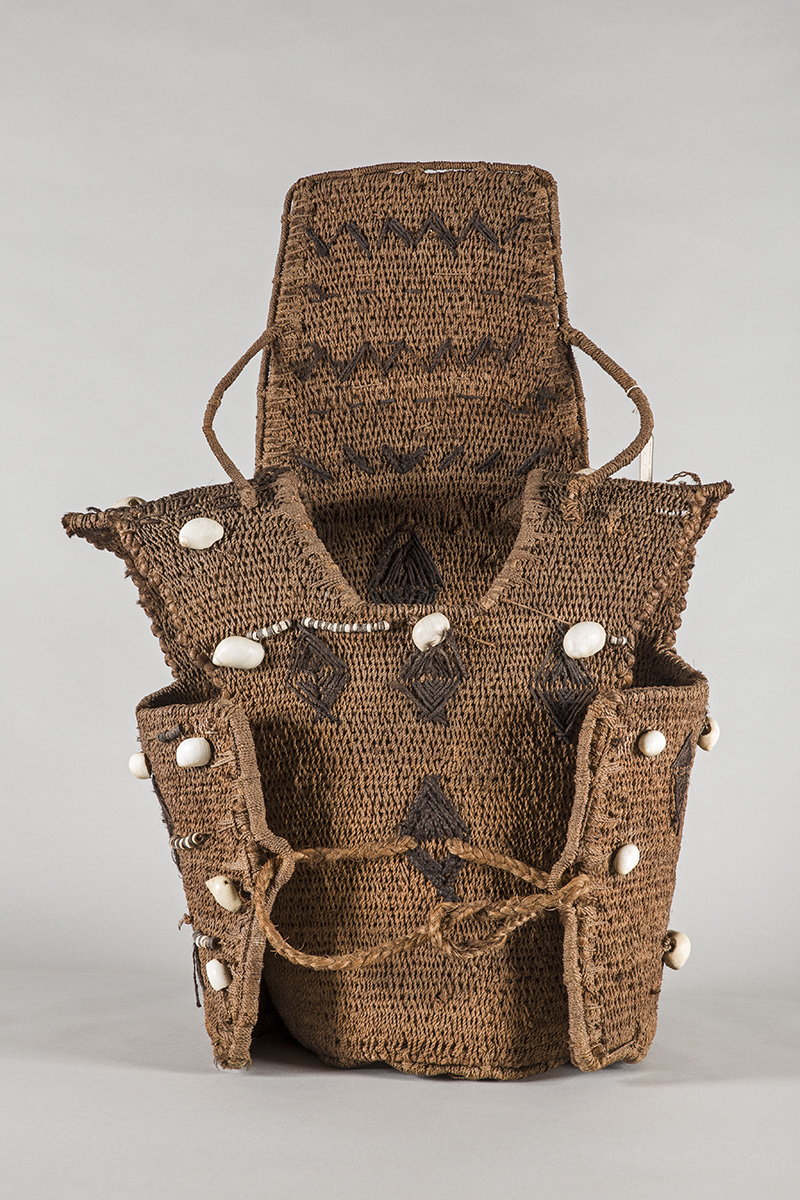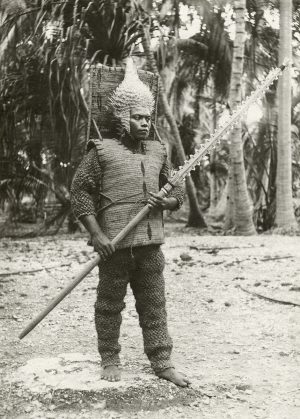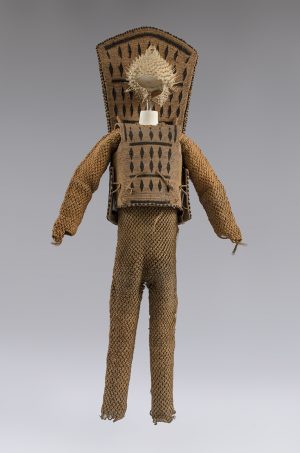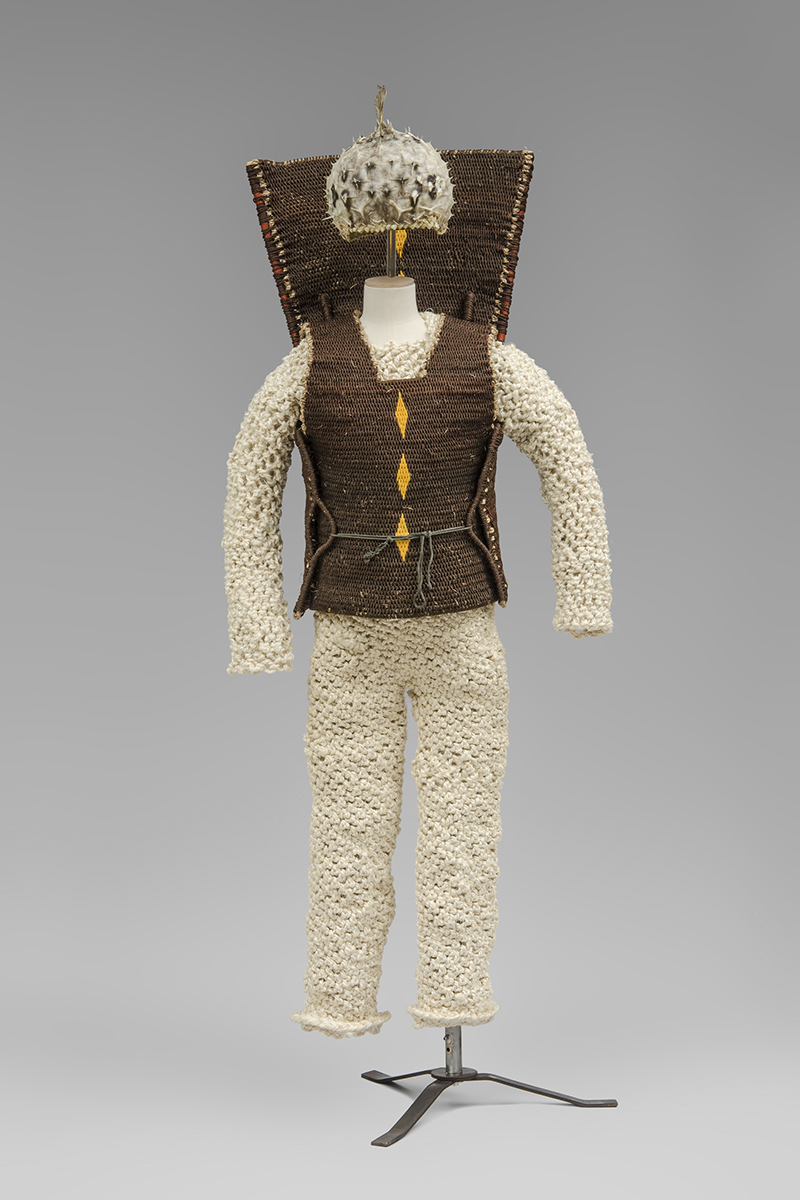
Kiribati cuirass with neck guard, 19th century or earlier, coconut fibre string ornamented with shells, human hair, and shell beads, 72.5 x 58.2 x 32 cm (1884.31.36, © Pitt Rivers Museum)
What we have, we use
The Republic of Kiribati is a group of thirty-three coral atolls and reefs spread out over 3.5 million square kilometers of the Pacific Ocean. It is located in Micronesia, a region in the Western Pacific. Isolated as an island group, the Islanders use the limited resources they have on hand to produce their material culture.

One of the senior students at Rongorongo training college, Beru, wearing Kiribati armor, before 1925 (Photo: George Hubert Eastman, © Museum of Archaeology and Anthropology, University of Cambridge)
Historically, the I-Kiribati produced extraordinary objects such as suits of armor made from coconut fiber. The armor provided protection from the dangerous shark’s-teeth-edged swords, spears, and daggers carried by island warriors. Each suit is made up of a set of overalls and sleeves made from coconut fiber, with a coconut fiber cuirass worn over the top. The distinctive cuirasses have high backboards to protect from attack from behind, and were often worn with thick belts made from woven coconut fiber or dried ray skin to protect the vital organs. The cuirasses are usually decorated, either with human hair, feathers or shells.
Warriors sometimes wore hand armor also made from coconut fiber, inlaid with shark’s teeth along the knuckles. The warriors would also wear fearsome-looking helmets made of porcupine fish skin, which dried hard in the sun and provided another layer of protection for the head. These helmets would usually have been worn over a coconut fiber or woven pandanus leaf cap.
It is not known where and when this type of armor was developed in the islands, but it has come to stand as uniquely Kiribati, with its influence also spreading to the nearby islands of Nauru and Tuvalu.
Making the armor

Coconut fiber cuirass with struts, decorated with human hair, with porcupine fish helmet (photo: Josh Murfitt, Museum of Archaeology and Anthropology, University of Cambridge)
Coconut fiber string, a material still produced and used today, is the main material used for the armor, chosen not just for its availability but also its strength and flexibility. The fibers come from the husk of the coconut, found between the inner shell and the outer skin. These fibers are soaked in the water of the lagoon for two to three months, then rinsed and dried. Several fibers are rolled into small strands, which are then rolled together to create long cords.
Many of the cuirasses feature lozenge-shaped or geometric designs made from human hair; sometimes these diamond shapes are developed to become fish or turtles. Hair is something quite special and precious, but is also easily accessible. The woven diamond motif seen here is most likely women’s hair. Often combined with coconut fiber, hair was also used for binding the shark’s teeth to swords, and is still used today in dance belts.
The process of making the armor would have been associated with a powerful ritual, instilling in the armor the power and strength of the raw materials used to make it. The warriors would also go through a ritual before going into battle.
Wearing the armor
The armor would have been worn in conflict resolution between individuals or groups of people. Generally the fighting would have been related to land claims or retribution. In all contests, the aim was to wound your adversary, not to kill them, as a wound would be adequate retribution. If someone did die during the battle then payment to the wronged party would need to have been made through the gift of land.
Warriors in armor would have carried a shark’s-tooth spear tipped with a stingray barb. They would never have fought alone, but would have been surrounded by a number of people who were not wearing full armor, carrying branched spears, clubs, and small daggers. In cases of inter-village or island warfare, each side would march in three groups, with the main warriors in the center surrounded by their supporting troops. When the two sides met, the overall outcome would depend on the result of individual challenges made by the warriors.

The Gilbert Islands, Phoenix Islands, Line Islands, and Banaba make up the Republic of Kiribati (map © Mark Gunning, 2017)
Encounters with westerners
Pedro Fernandes de Queiros was the first European to sight the Gilbert Islands (the main group of islands in what is now the Republic of Kiribati) in 1606. The British explorers John Byron, Thomas Gilbert, and John Marshall all passed through the sixteen atolls without landing between 1764 and 1788. The islands were named the Gilbert Islands by the Russian general Adam Johann von Krusenstern, who also crossed without landing in 1820. The French captain Louis Duperrey then mapped the islands fully in 1824.
There are records of Kiribati armor in European collections as early as 1824 [1], but there are no known descriptions of it in historical records until 1844, when the United States Exploring Expedition published an account of their arrival on Tabiteuea (an atoll in the Gilbert Islands). Whalers and blackbirders from Australia, the United States, and Europe also visited the islands during the 1800s, often settling there for periods and taking home the armor they acquired.
The rapid decline in the production of this type of armor is generally attributed to the influence of missionaries, who first arrived from France in 1888, and the British, who arrived 1892, both of whom introduced new laws and attempted to pacify the islands. I-Kiribati do not commonly make anything that is not needed; a lack of further need for the armor is likely one of the reasons that these objects were offered to tourists, government officials, explorers, whalers, and other visitors, and why so many are now found in museums across the world.

Kiribati armor made by Kaetaeta Watson, Chris Charteris, and Lizzy Leckie, 2016 (2017.14.1-3, Copyright Museum of Archaeology and Anthropology, University of Cambridge)
Kiribati armor today
Small decorative shark’s-teeth daggers are still produced for tourists. However, suits of armor are no longer made for use. Today, historic suits of armor can be found in Kiribati on exhibition at Te Umwanibong, the Kiribati Museum and Culture Centre on Tarawa atoll, but it is not known that any others exist in the islands.
In 2016, the Pacific Presences project, based at the Museum of Archaeology and Anthropology, University of Cambridge commissioned New Zealand-based artists Chris Charteris, Lizzy Leckie, and Kaetaeta Watson to make a new suit of armor. This armor, named Kautan Rabakau, is now part of the permanent collection of the Museum of Archaeology and Anthropology.
Kiribati became an independent nation in 1979, and since then the image of the “warrior” has re-emerged, and can be seen used on clothing and as mascots for sports teams—a symbol of strength and pride. It has also been repurposed by the Mormon faith Moroni High School in Tarawa, who see themselves as fighting both a spiritual and physical war in the modern world.
While the battles that necessitated this armor are over, Kiribati now faces the new challenges of climate change and the effects of westernization on traditional life and culture.
The research for this entry was produced during the European Research Council funded project: ‘Pacific Presences: Oceanic Art and European Museums’, under the European Union’s Seventh Framework Programme (FP7/2007-2013) / ERC grant agreement n° [324146]11.


